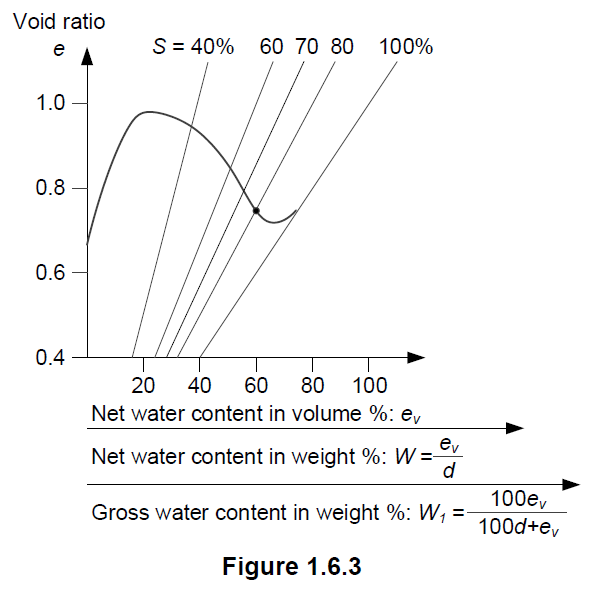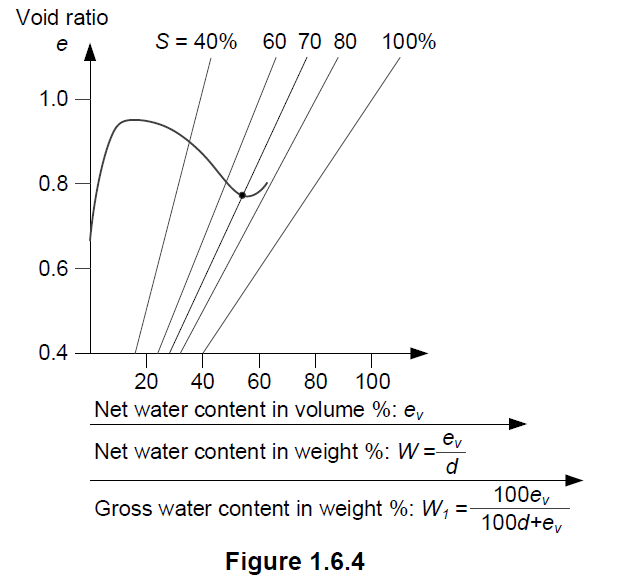- .4 Compaction
Compaction tests are
executed for five to ten (but typically seven) different moisture
contents (i.e. typically seven but five to ten separate tests). The
number of tests should fully define the compaction curve, including
accurately determining the optimum moisture content and conditions near
to or at full saturation. A total of about 40 kg to 100 kg of unscreened
Bauxite is typically needed for one series of tests, depending on
whether reconstitution is required or not.
Divide the
screened Bauxite into five to ten subsamples and place each in a sealed
plastic bucket. The water content of the subsamples are adjusted by
adding a suitable amount of water into each bucket in order to obtain
water contents ranging from the as-received water content to almost
saturated subsamples.
Typically one test is carried
out at the as-received water content. Four to eight tests are carried
out at higher water contents. Depending on the as-received water
content, one or two tests are carried out at lower water contents than
the as-received water content. These lower water content tests are
obtained by partially drying the Bauxite subsample at room temperature.
Note that full drying of the Bauxite samples is not to be carried out.
Note that some Bauxites are not sensitive to pre-drying, but unless this
is comprehensively demonstrated for the Bauxite being tested, pre-drying
is not permitted.
The subsamples are mixed at the
target water contents before being allowed to rest and equilibrate
overnight in the sealed plastic buckets. The plastic bucket contents are
remixed immediately before compaction to ensure that a homogeneous
sample is tested.
The required quantity of prepared
Bauxite per compaction test is about 5 kg, so this is the target amount
for each subsample. The subsamples will be compacted at the prepared
water contents to define a full compaction curve.
Approximately one fifth of the subsample in a plastic bucket is filled
into the mould with the extension piece attached (figure 1.6.1) and
levelled to form the first layer increment. Bauxites that display
plasticity may tend to stick together into clumps at the wetter water
contents. It is important to gently disaggregate the clumps by hand into
the small particles when loading the mould.
The Bauxite
is then tamped uniformly over the surface of the layer. Tamping is
executed as per the Proctor/Fagerberg method D, by dropping a 150
g hammer 58 times through the guide pipe, 0.15 m each time. The guide
tube is held by hand and positioned so that it is just touching with the
surface of the ore, but is not resting on it. This allows the hammer to
fall the full specified height and compact the Bauxite, while avoiding
additional (and excessive) compaction arising from the weight of the
guide tube, itself, which should not be compressing the Bauxite.
The performance is repeated for all five layers so that the
last layer only just overfills the mould-extension piece junction. The
aim is to fill the mould by compacting in five nearly equal layers in
order to produce a uniformly compacted sample in which the specified
energy has been put into Bauxite that occupies the mould volume.
Bauxite should not extend more than 1 cm in height above the
mould into the extension piece. If a height of more than 1 cm of Bauxite
is found, the sample has been under compacted and the test should be
redone.
When the last layer has been tamped the
extension piece is removed and the sample is levelled off along the brim
of the mould with care, ensuring to remove any large particles that may
hinder levelling of the sample, replacing them with material contained
in the extension piece and re-levelling.
The levelling
process should be a horizontal cutting action, not a pushing action as
that would compress more material into the mould volume than had been
compacted by the specified energy input.
After the
weight of the cylinder with the tamped sample has been determined, the
cylinder is emptied, the full sample is dried at 105oC as per
ISO moisture determination standard for Bauxite (ISO 9033:1989
"Aluminium ores - Determination of the moisture content of bulk
material") and the weight is determined. The test is then repeated for
the other samples with different moisture contents.
- .5 Definitions and data for calculations (see figure
1.6.1)
- empty cylinder, mass in grams: A
- cylinder with tamped sample, mass in grams: B
- wet sample, mass in grams: C
- dry sample, mass in grams: D
- water, mass in grams (equivalent to volume in
cm3): E
Volume of cylinder: 2304.5 cm3
- .6 Calculation of main characteristics
-
density of solid material, g/cm3 (t/m3): d
- dry bulk density, g/cm3 (t/m3):

- net water content, volume %:
ev
- void ratio: e (volume of voids divided by
volume of solids)
- degree of saturation, percentage by volume:
S
- gross water content, percentage by mass:
W1
- net water content, percentage by mass:
W
- .7 Presentation of the compaction tests
For each compaction test the calculated void ratio (e) value is
plotted as the ordinate in a diagram with net water content
(ev) and degree of saturation (S) as
the respective abscissa parameters.

Form of Bauxite
compaction curve when the optimum moisture occurs at a saturation
greater than 90%. TML is determined as the critical water content at 80%
saturation.

Form of Bauxite
compaction curve when the optimum moisture occurs at a saturation less
than 90%. TML is determined as the critical water content at 70%
saturation.
- .8 Compaction curve
The test sequence
results in a specific compaction curve (see figures 1.6.3 and 1.6.4).
Should the optimum moisture content (OMC) of Bauxite
occur at or above 90% saturation, the critical moisture content is
indicated by the intersection of the compaction curve and the line
S = 80% degree of saturation (see figure 1.6.3). The TML is
the critical moisture content.
Should the optimum
moisture content (OMC) of Bauxite occur below 90% saturation, the
critical moisture content is indicated by the intersection of the
compaction curve and the line S = 70% degree of saturation (see
figure 1.6.4). The TML is the critical moisture content.
Where the OMC is not clearly defined by carrying out a
sufficient number of tests at water contents close to and either side of
the OMC, then a TML based on S = 80% cannot be adopted. The TML
shall be based on S = 70%. This is to guard against the erroneous
adoption of a high OMC due to insufficient definition of the compaction
curve.
Where moisture very freely drains from the
sample at moisture content such that the test sample compaction curve
does not extend to or beyond 70% saturation, the test is taken to
indicate a cargo where water passes freely through the spaces between
particles.